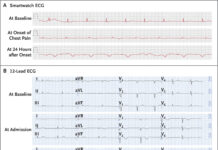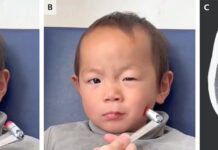
Patient with initial known thyroid disease diagnosed with myxedema coma complicated by pancytopenia.
A 71-year-old female patient presented to the hospital for refusal to eat, walk or talk. She had a medical history of dementia and depression. Her prescription medications included carbidopa-levodopa, memantine, quetiapine, selegiline, and sertraline. According to the patient’s family, she had been taken to multiple hospitals by now and had always been diagnosed with dementia. She would get her prescriptions from emergency departments. In addition, she did not have a primary care physician and it was not clear who had initially prescribed her the medication.
Physical examination
Her vital signs showed hypothermia with a temperature of 91°F (32.8°C). She was bradycardic with blood pressure 128/72 mm Hg and oxygen saturation of 90% in ambient air. Similarly, physical examination was remarkable of cachexia with withdrawal to pain. Her heart rhythm and rate were normal and nonedematous extremities. She did not have any signs of hair loss on her head. There were no other significant findings on physical examination.
The patient’s systolic blood pressure decreased to 60 mm Hg while she was in the emergency department. She was unresponsive to resuscitation with intravenous fluids. The Emergency Room physicians gave her vasopressin for maintaining adequate mean arterial pressure for perfusion. However, her mental status deteriorated even further and she transitioned to a soporous state. Doctors advised intubation for airway protection. Doctors discontinued all of her medications.
Investigations and findings
The patient’s urinalysis was not significant of an infectious process and had a negative urine toxicology. Blood culture and urine culture were also unremarkable. There were no significant findings on the chest X-ray either. According to the reviewing radiologist, computed tomography of the head without contrast showed posterior reversible encephalopathy syndrome, sequela of hypoglycemia, or progressive multifocal leukoencephalopathy (PML) in the proper clinical setting. MRI was remarkable of multifocal areas of recent ischemic infarction.

Diagnosis: myxedema coma
The findings led to a probability of myelodysplastic syndrome (MDSs). Doctors advised a bone marrow biopsy to confirm. However, her family refused the procedure. Therefore, a peripheral blood smear and flow cytometry were obtained. Blood smear showed a decrease in white blood cells, decreased platelets, few hypolobulated and hypergranular neutrophil and rare polychromasia without tear drop cells. Serum electrophoresis and flow cytometry were normal. Serum vitamin B12 and folate were also within normal range.
The most likely diagnosis was myxedema coma. Treatment included normal saline and broad-spectrum antibiotics. Her WBCs and platelet count showed improvement with treatment 13 days after treatment. However, there was a sudden decline in the patient’s hemoglobin on day 18. Her CBC was repeated and she was given 2 units of packed red blood cells. There were no signs of hemorrhage and hemolysis. Her hemoglobin showed improvement after transfusion. Unfortunately, the patient died 32 days after admission without returning to a conscious state.
References
Myxedema Coma Complicated by Pancytopenia https://www.ncbi.nlm.nih.gov/pmc/articles/PMC6664498/



